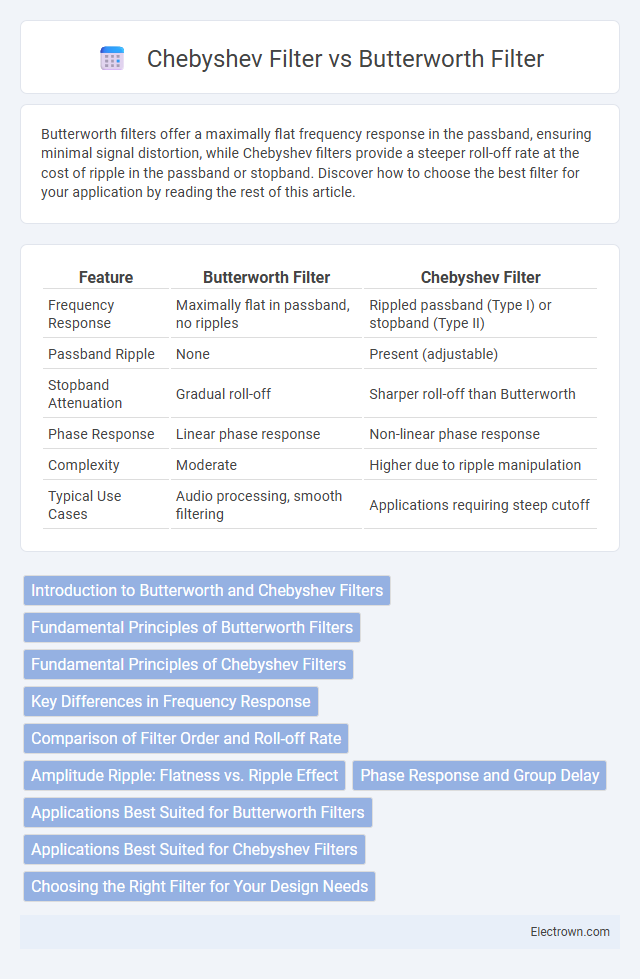Butterworth filters offer a maximally flat frequency response in the passband, ensuring minimal signal distortion, while Chebyshev filters provide a steeper roll-off rate at the cost of ripple in the passband or stopband. Discover how to choose the best filter for your application by reading the rest of this article.
Table of Comparison
| Feature | Butterworth Filter | Chebyshev Filter |
|---|---|---|
| Frequency Response | Maximally flat in passband, no ripples | Rippled passband (Type I) or stopband (Type II) |
| Passband Ripple | None | Present (adjustable) |
| Stopband Attenuation | Gradual roll-off | Sharper roll-off than Butterworth |
| Phase Response | Linear phase response | Non-linear phase response |
| Complexity | Moderate | Higher due to ripple manipulation |
| Typical Use Cases | Audio processing, smooth filtering | Applications requiring steep cutoff |
Introduction to Butterworth and Chebyshev Filters
Butterworth filters provide a maximally flat frequency response in the passband, ensuring minimal signal distortion, while Chebyshev filters offer a steeper roll-off with ripple either in the passband (Type I) or stopband (Type II). Butterworth designs prioritize smooth amplitude characteristics, making them ideal for applications needing consistent signal fidelity. Your choice between these filters depends on the trade-off between passband flatness and transition sharpness in your signal processing requirements.
Fundamental Principles of Butterworth Filters
Butterworth filters are designed to have a maximally flat frequency response in the passband, meaning they exhibit no ripples and provide a smooth amplitude characteristic. Their transfer function is characterized by poles evenly spaced on a semicircle in the left half of the complex plane, ensuring stability and monotonic roll-off. This results in a gradual attenuation beyond the cutoff frequency, making Butterworth filters suitable for applications requiring a clean, distortion-free signal.
Fundamental Principles of Chebyshev Filters
Chebyshev filters are designed based on the principle of minimizing the error between the ideal and actual filter response in the passband, resulting in ripples that allow for a steeper roll-off compared to Butterworth filters. They achieve faster transition from passband to stopband by allowing ripple in either the passband (Type I) or stopband (Type II), optimizing your filter's frequency selectivity. The fundamental design relies on Chebyshev polynomials, which define the amplitude response and provide greater control over filter sharpness and ripple behavior.
Key Differences in Frequency Response
Butterworth filters exhibit a maximally flat frequency response in the passband, ensuring no ripples and a smooth transition but with a relatively gradual roll-off rate. Chebyshev filters offer a steeper roll-off compared to Butterworth filters by allowing ripples in either the passband (Type I) or stopband (Type II), enhancing selectivity at the cost of amplitude variations. The choice between these filters depends on the application's tolerance for ripple and the need for sharp cutoff characteristics in frequency response.
Comparison of Filter Order and Roll-off Rate
Butterworth filters provide a maximally flat frequency response with a moderate roll-off rate, requiring higher filter order to achieve steep attenuation compared to Chebyshev filters. Chebyshev filters achieve a steeper roll-off rate with a lower filter order by allowing ripple in the passband or stopband, resulting in faster transition between passband and stopband frequencies. The choice between the two involves trade-offs between smoothness of frequency response (Butterworth) and sharper cutoff with ripple tolerance (Chebyshev).
Amplitude Ripple: Flatness vs. Ripple Effect
Butterworth filters provide a maximally flat amplitude response in the passband, ensuring no ripples and smooth signal preservation, making them ideal when amplitude uniformity is critical. Chebyshev filters introduce ripples in the passband amplitude to achieve a steeper roll-off, trading flatness for sharper cutoff characteristics. Your choice depends on whether you prioritize amplitude flatness for signal fidelity or sharper transition edges with acceptable ripple distortion.
Phase Response and Group Delay
Butterworth filters exhibit a maximally flat magnitude response with a smooth phase response, resulting in minimal phase distortion and nearly linear group delay, which preserves signal waveform integrity. Chebyshev filters provide a steeper roll-off but introduce ripple in the passband, causing nonlinear phase response and more pronounced group delay variations that can distort your signal's timing. Choosing between these filters depends on whether you prioritize phase linearity and minimal delay distortion (Butterworth) or sharper cutoff characteristics (Chebyshev).
Applications Best Suited for Butterworth Filters
Butterworth filters are best suited for applications requiring a smooth, flat frequency response in the passband, such as audio processing and biomedical signal filtering. Their maximally flat magnitude response ensures minimal signal distortion, making them ideal for You when preserving signal integrity is critical. Unlike Chebyshev filters, which introduce ripple in the passband or stopband, Butterworth filters provide a more natural sound or signal quality in sensitive measurement systems.
Applications Best Suited for Chebyshev Filters
Chebyshev filters are best suited for applications requiring a rapid transition between the passband and stopband, such as in communication systems and signal processing where filter sharpness is critical. Their steeper roll-off compared to Butterworth filters makes them ideal for scenarios demanding precise frequency discrimination, like audio equalization and RF filtering. The trade-off of passband ripple is acceptable in many detection and instrumentation tasks where sharper cutoff and reduced filter order improve overall system performance.
Choosing the Right Filter for Your Design Needs
Butterworth filters offer a maximally flat frequency response ideal for applications requiring a smooth, ripple-free passband, while Chebyshev filters provide steeper roll-off rates at the cost of passband ripple, making them suitable for designs needing sharper cutoff characteristics. Your choice depends on whether you prioritize signal fidelity or sharper frequency discrimination in the system. Consider the specific ripple tolerance, transition bandwidth, and phase linearity requirements to select the filter best aligned with your design goals.
Butterworth filter vs Chebyshev filter Infographic

 electrown.com
electrown.com